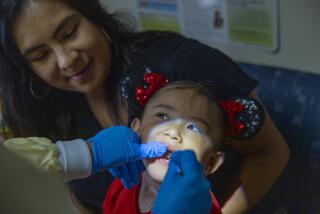On the Move With the Plaque Police
- Share via
They are the protectors of your teeth and gums, the people most likely (next to your dentist) to remind you to floss, brush and rinse.
Dental hygienists are now employed at more and more independent dentists’ offices. More than 60% of independent dentists employ at least one, according to the American Dental Assn. Survey of Dental Practices.
Many hygienists work for more than one dentist, traveling from office to office. Flexibility is one draw to this career of cleaning teeth and promoting good dental practices, with hygienists often able to choose how many days per week they will work.
We caught up with Lilyan Patterson, a 29-year-old Long Beach dental hygienist who began her career six years ago. She now works for three dentists: Christine Dumas of Marina del Rey, C. John Dehner of Huntington Beach and Bette Robin of Claremont. She puts in a 36-hour week over four days.
*
So, how many mouths do you tend to in a typical day?
“Usually eight adults, and that’s an eight-hour day. That’s not typical [for dental hygienists]; I’ve picked dentists who allow an hour for each patient.”
*
And how many of those mouths--be honest--get a passing grade?
“Most people I’d give a B to a C.”
And what would they have to do to improve that grade?
“Floss every day. And a lot of my patients brush only once a day. I recently had a little 10-year-old girl tell me, ‘I brush four times a week. I don’t brush on the weekends.’ ”
*
What inspired you to become a dental hygienist?
“I was a dental assistant first and wanted to move up. I like the flexibility. I can work one day or five.”
*
How has the profession changed in the six years you have been in it?
“It’s become more preventive. We have become more aware of preventive practices to help fight periodontal disease, so our patients don’t end up at the periodontist’s office, or if they do, the treatment can be less intensive.
“They’ve come up with intra-oral cameras, so it’s much easier to educate the patient. It’s basically a TV screen with a wand that goes inside the mouth. I can show inflammation, explain what a periodontal pocket is, show plaque . . . broken or cracked teeth.”
*
Any tricks you’ve discovered to make the floss-and-brush routine less deadly dull?
“Keep [floss] accessible, whether you keep it in your pocket or purse. You can [floss] in the car. You can do it when watching TV. You can dry-brush your teeth in the car.”


